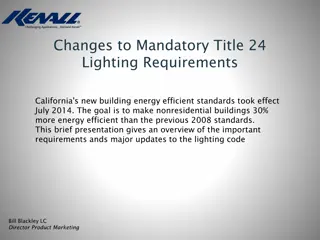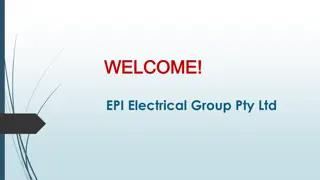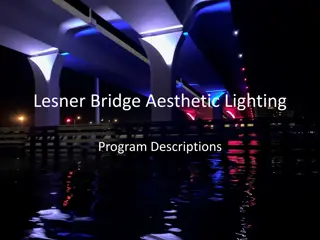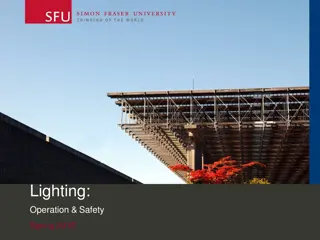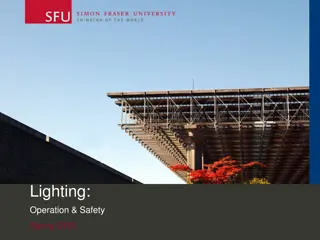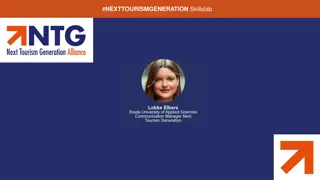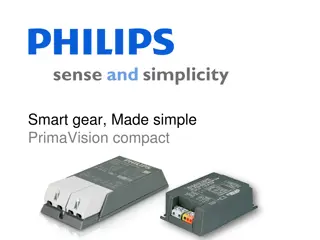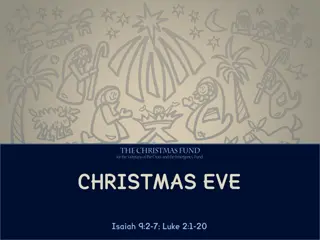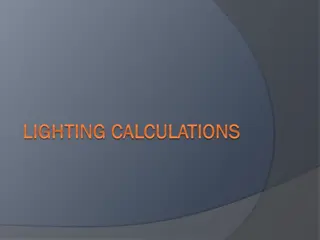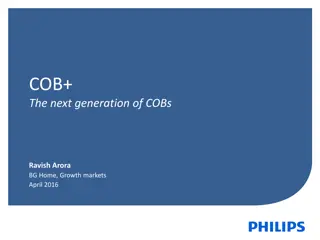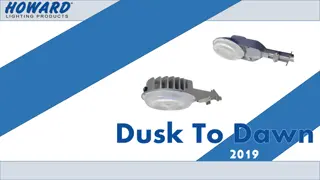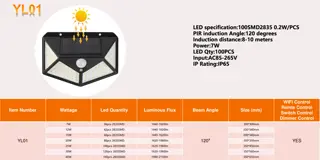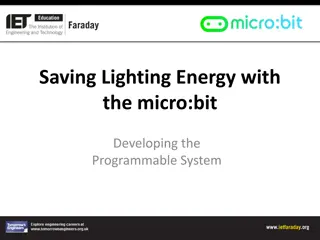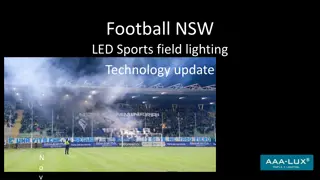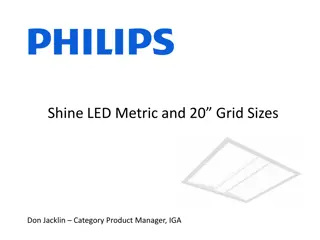LED Market Assessment and Lighting NTG Study Findings
This document presents the findings from an LED market assessment and lighting NTG study conducted in June 2015. The study includes evaluation tasks such as demand elasticity modeling, supplier interviews, data analysis, and overall reporting. Task leaders were assigned for each specific task to ensure comprehensive coverage. The study delves into demand elasticity, data sources, predicted vs. actual sales, and estimates regarding freeridership in the LED market.
Download Presentation

Please find below an Image/Link to download the presentation.
The content on the website is provided AS IS for your information and personal use only. It may not be sold, licensed, or shared on other websites without obtaining consent from the author.If you encounter any issues during the download, it is possible that the publisher has removed the file from their server.
You are allowed to download the files provided on this website for personal or commercial use, subject to the condition that they are used lawfully. All files are the property of their respective owners.
The content on the website is provided AS IS for your information and personal use only. It may not be sold, licensed, or shared on other websites without obtaining consent from the author.
E N D
Presentation Transcript
LED Market Assessment and Lighting NTG Study June 22, 2015 Presented by: Lisa Wilson-Wright (NMR) With support from: Jason Christensen (Cadmus) Scott Reeves (Cadmus) Christopher Dyson (DNV GL) Michael Strom (NMR) David Barclay (NMR) Kiersten von Trapp (NMR) www.nmrgroupinc.com
Evaluation Tasks Task 1: Demand Elasticity Modeling Task 2: Supplier Interviews* Task 3: Reanalysis of Saturation Data, Comparison to other Areas* Task 4: Point-of-Sale (POS) Data Modeling* Task 5: Overall Reporting *Leverage resources with MA 2
Task Leaders Task 1: Demand Elasticity Modeling Cadmus: Scott Reeves, Jason Christensen Task 2: Supplier Interviews DNV GL: Chris Dyson Task 3: Saturation Reanalysis NMR: David Barclay, Kiersten von Trapp Task 4: POS Data Modeling NMR: Michael Strom 3
Task 1 Demand Elasticity Model: Objectives Uses sales and promotion information to: Quantify the relationship of price and promotion to sales Predict likely sales levels without the program s intervention (baseline sales) Estimate freeridership by comparing modeled baseline sales with modeled program sales ??? ?? ?????????? = ??????? ??? ??????? ??????? ??? ??? ??????? ??????? ??? ??????? 4
Task 1 Demand Elasticity Model: Data Sources Data provided by implementer APT/CLEAResult: Program and non-program price Variation in price over time Data on external factors that affect price (e.g., specialty/standard, wattage, manufacturer, retailer, LED/CFL) Tracking data for merchandising/marketing activity 5
Demand Elasticity Predicted and Actual Sales 6
Task 1 Demand Elasticity Model: Net of Freeridership Estimate Company Net of Freeridership LED Specialty LED Standard CFL Specialty CFL Standard 71% 49% 47% 51% Specialty CFL Net of FR lower than standard Less elastic, less competition from halogens Uncertain why LED standard smaller than expected May reflect purchases by early adopters 7
Task 1 Demand Elasticity Model: Benchmarking Recent studies have standard CFL range of 51% to 83% CT is on low end of scale, but Programs included differ in duration, history, level of support CT Net of FR actually relatively low compared to incentive offered Highest Net of FR incented 63% of bulb price compared to 26% in CT CT incented bulbs with greater elasticity, achieved superior net lift relative to incentive budget 8
Task 2 Supplier Interviews: Objectives Estimate NTG ratios for supported lighting products Understand supplier perspectives on the program Describe state of the market 9
Task 2 Supplier Interviews: Methodology In-depth interviews: 12 lighting suppliers (93% of 2013 program sales) 4 high-level lighting buyers (34% of 2013 program sales) Conducted May-July 2014 in conjunction with MA Connecticut specific topics: NTG estimates Change in EE bulb sales absent program discounts By bulb type for program, retail channels Levels of satisfaction with CT lighting program Recommendations for program improvements 10
Task 2 Supplier Interviews: NTG Estimates Bulb Type Standard CFLs NTG Ratio 68% Specialty CFLs 55% LEDs 74% NTG dominated by reliance on big box stores NTG lower for specialty CFLs than standard 11
Task 2 Supplier Interviews: Program Satisfaction Very positive feedback on program staff Supplier/retailer recommendations for program improvements Longer program duration Three-year program rather than year-to-year More flexibility in RFP Bring in new retailers/promotions mid-year More funding for program incentives Most participate in both MA and CT programs and indicated that MA program had better incentives 12
Task 2 Supplier Interviews: Program Satisfaction 13
Task 2 Supplier Interviews: National LED Market Trends LED prices expected to decline Greater supply, EISA Technology, manufacturer changes Do not expect LED fixture prices to drop LED sales healthy High cost remains barrier to adoption Rebates, consumer education seen as best ways to increase adoption 14
Task 3 Saturation Reanalysis: Objectives Use prior saturation data (2009, 2012, 2013) to interpolate and extrapolate likely saturation rates in 2010, 2011, and 2014 Compare saturation data in Connecticut with data collected from Eastern Kansas and Georgia in conjunction with Massachusetts 15
Task 3 Saturation Reanalysis: Efficient Bulb Saturation Over Time 16
Task 3 Saturation Reanalysis: Lighting Comparisons *CT 2014 is forecasted 17
Task 3 Saturation Reanalysis: Saturation by Bulb Type 18 *CT 2014 is forecasted
Task 4 POS Modeling: Objective and Background Explore impact of lighting program activity on efficient bulb sales Utilizing nationwide sales data Use analysis to derive counterfactuals Estimates of sales in absence of program to calculate NTG ???? =(# ????? ???? ??? ??????? # ????? ???? ??? ?? ???????) # ?? ??????? ???????? ????? ???? 19
Task 4 POS Modeling: Inputs Series of state-level regression models predicting: Proportion of reported bulb sales that were efficient Model inputs: Sq. Ft. of major reporting and non-reporting retail channels Demographic variables of interest Program activity variable % efficient sales in non-program states 20
Task 4 POS Modeling: NTG Ratio Estimates Product CFLs LEDs NTG 29% 87% Dataset covers only 19% of program sales inclusive of CFLs and LEDs (so smaller for LEDs) LEDs very small part of market in 2009, different types of bulbs Most general service LEDs sold through channels not in dataset Dataset does not distinguish specialty from standard Modeled relationship between budget, % efficient sales States with larger budgets show higher NTG 21
Summary of Net-Freeriders / Net-to-Gross PY 2013 Measure Company Assumptions Task 1: Demand Elasticity Task 2: Supplier Interviews Task 4: POS Modeling LED Specialty LED Standard CFL Specialty CFL Standard Notes 71% 100% 74% 88% 49% 47% 55% 81% 29% 51% 68% From the 2014 PSD, Appendix 3; net realization rates are 82% for LEDs and 51% for CFLs Net of freeridership, partial or missing data required team to make assumptions for some products, stores Subject to biases of responding manufacturers and retailers Partial market estimate, home- improvement/hard ware channels not included. Limited applicability for program LEDs 22
Recommended NTG NTG = 51% for CFLs for 2013 Estimated values coalescence at this level NTG = 82% for LEDs for 2013 Higher than estimated values but none offered strong estimates for LEDs Expect CFL NTG to stay stable Competition from halogens, LEDs Expect LED NTG to stay high through 2015, but start dropping quickly around 2016 Declining prices, consumer acceptance 23
Other Recommendations Estimate NTG regularly for next few years Include estimates for channels (especially hard-to-reach) Include estimates for specialty and standard LEDs Period of rapid change, uncertainty MA developed from multiple methods, consensus building process to produce retro-/ prospective values 24
Other Recommendations Continue practice of gradual increase for LEDs, phasing out of CFLs But not too fast! Consider shifting some support from home improvement to other channels DIY generally have low NTG compared to others Cease specialty incentives Companies already planning this Increase LED awareness Through current, expanded education, outreach 25
Plans for 2015 Lighting Study Goal: Assess trends in lighting market Emphasize updating information to reflect current (and trending) LED market Provide values that can be incorporated into savings estimates, future plans, PSDs Study objectives: Estimate of efficient socket saturation, bulb penetration Provide data on baselines, delta watts Provide customer, equipment, market data in support of program targeting, planning 26
Two Tasks Task 1: Consumer recruitment survey n=150 residential customers Check-in on key market indicators Recruit for on-sites Task 2: On-site saturation visits n=75 (or more if possible) Determine socket saturation, bulb penetration, bulb storage (all types) Collect info on delta watts Understand consumers lighting purchases 27







